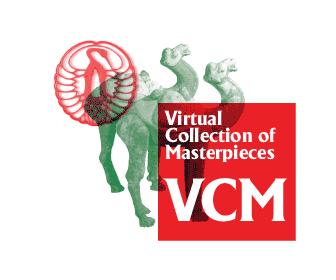Online collection of masterpieces by European and Asian museums
The Slovene Ethnographic Museum (department for ethnological collections from Asia, Oceania and Australia) on 2 March 2012 joined the ASEMUS project (Asia - Europe Museum network: https://culture360.asef.org/asemus-culture360/). The database was acquired by Culture360.ASEF.org, where SEM presents itself with ten masterpieces from the Asian collection SEM:
• A mandarine clothing /Long pao/, Qing dynasty, 19th century, China, silk, golden and silver thread, length: 138 cm, width: 220 cm., bought in 1974 from Mr. Savič Petar, Molerova 76, Belgrade, Yugoslavia. (Inv.no.: EM 21665)
• A mandarine clothing /Long pao/, Qing dynasty, 19th century, China, silk, length: 140 cm, width: 210 cm., Skušek donation in 1963. (Inv.no.: EM 21666)
• A buddhistic statue, Yamantaka, 16th century ?, Tibet, bronze, height: 32,5 cm, length: 26 cm, width 15 cm., Skušek donation in 1963. (Inv.no.:EM 21670)
• Ladies shoes, Qing dynasty, 19th century, China, silk, cotton, length: 12 cm, height: 7 cm, width: 5 cm., Skušek donation in 1963. (Inv.no.:EM 21683)
• A drum made out of a skull, 19th century, Tibet, diameter: 14 cm and 13 cm, length: 40 cm ( with the ribbon), Skušek donation in 1963. (Inv.no.:EM: 21685)
• A folding fan, Qing dynasty, 19th century, China, ivory, silk, embroidery, diameter: 27,5 cm, length of the handle 15 cm., Skušek donation in 1963. (Inv.no: EM 21686)
• Buddha Gautama, 16th century ?, Tibet, bronze, height: 19 cm, length: 13,5, width 9,5 cm, Skušek donation in 1963. (Inv.no: EM 21689)
• A mirror, Qing dynasty, 19th century, China, wood, 196 x 94 x 69,5 cm, Skušek donation in 1963. (Inv.no: EM 21701)
• A cabinet; Qing dynasty, 19th century, China,wood, ( it belonged to the first president Yüan Shi k'ai), 188 x 94 x 37 cm. Skušek donation in 1963. (Inv.no: EM 21704)
• A mandarine clothing /Long pao/, Qing dynasty, 19th century, China, silk, golden and silver thread, length: 141 cm, width: 202 cm., Skušek donation in 1963. (Inv.no.: EM 21706)
The first Asian object known so far, which came to the Carniolian Provincial Museum Rudolphinum in 1836 ( the forerunner of the Slovene ethnographic Museum in Ljubljana which was founded in 1921) was an album of Chinese fencing which travelled from China to the United States of America and then to Europe – Austrio-Hungarian Empire to Villach/Carinthia and from there to Ljubljana. And it was probably the first non-European object in the museum collections. Several individuals (a sailor and some bourgeois) donated the museum a few objects mainly from China (fans, small women shoes, sculptures, opium pipes, mah jong, some old coins...).
In 1912/13 an important collection of buddhistic sculptures, clothing, textile was sent from China by a slovene franciscan missionary Peter Baptist Turk, who lived mainly in the province of Hubei from 1901 until his death in 1944.
In 1963 the museum acquired the most important chinese collection from the late Ivan Skušek Jr. and his japanese wife Tsuneko Kondo. Skušek lived in Beijing from 1914-1920 and extensively collected chinese antiquities. He even acquired some cupboards of the first president Yuan Shi Kai. The collections consists of furniture of great quality, numismatics, mandarine clothing, Chinese and Tibetan buddhistic sculptures, chinaware, jade seals, albums with paintings, Chinese lanterns, fans ...
From the sixties and onwards several individuals donated or sold different kind of objects, mainly chinaware, clothing... The most important japanese collection our museum aquired in the beginning of 21st century from the heirs of the late Dr. France Kos an ethnologist and a former Yugoslav ambasador in Japan. He collected japanese woodcuts.
From India the museum aquired a Bengal Slovene missionary collection, mainly small sculptures and brass items. They must be about 100 years old. Some Indian students sold in the sixties Indian clothing and textiles from different parts of India, mainly Gujerat (sarees, dhoti...).
In the seventies some Slovene alpinists donated some brass items (holders...) and jewellery from Nepal and Tibet. The last important and big collection from Indonesia was donated in 1964 by dr. Aleš and Vera Bebler, a former Yugoslav ambasador to Indonesia. He collected mainly puppets (Wayang golek and kulit) and textiles (batik, ikat...).
In the last years we aquired a collection of Chinese naive Art – peasant painters from Shaanxi province from Mr. Milan Kovač and last but not least, yesterday we aquired a collection of Chinese kites also from Mr. Milan Kovač, a Slovene arhitect, who does conservation work in China for the last ten years.



